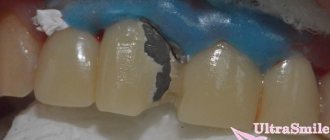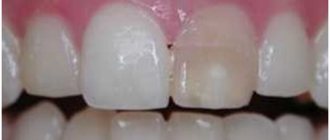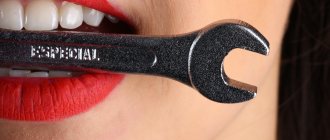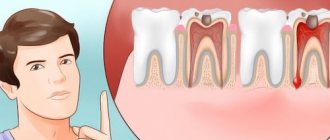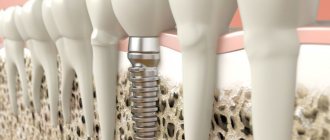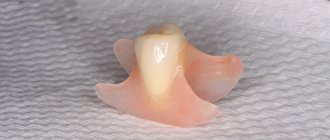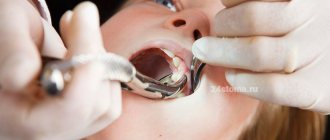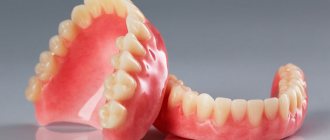Author: Brodsky Sergey Evgenievich Deputy Chief Physician, Candidate of Medical Sciences in the specialties: dentistry and medical microbiology What to do if there is a smell under a dental bridge, a tooth is broken or a bridge has fallen off, how to glue a dental bridge? Read on..
How is a dental bridge installed?
After deciding on bridge prosthetics, the dentist, at the very end of the work, must secure the dental bridge to the supports using glass ionomer cement or fixing screws. In dentistry, there are left and right, anterior and posterior supporting elements for bridges. The support can be either your own teeth or implants. As a rule, the left, right, anterior and posterior reference points are the same: these are either teeth or implants. Experienced prosthetists do not recommend installing and replacing dental bridges on mixed elements:
- in front is a tooth;
- behind - an implant or vice versa.
Patients often ask: “Why does a dental bridge fall out?” In the next paragraph we will tell you what to do if the bridge is loose in your mouth. How a bridge is attached to teeth or implants, photo.
Just CALL US!
+7
We will answer any of your questions and will definitely help you!
Why does a dental bridge wobble?
So, if a bridge made of cermet, zirconium, plastic or metal is shaking, the reasons for this are:
- Falling out or peeling off of the dental core tab or loosening of the fixing screw in the implant;
- Destruction of the anterior or posterior or (both) supports, no matter the tooth or implant;
- Atrophy of bone tissue and exposure of the gums around the root of the abutment tooth or the intraosseous part of the implant;
- Trauma (strike or fall);
- Incorrect load on the prosthetic structure, overestimation or underestimation of the bite (doctor’s error);
- Bruxism and hypertonicity of the masticatory muscles;
- Hormonal and systemic diseases of the body.
Thus, if the dental bridge begins to wobble, you should immediately consult a dentist. Timely removal of dental bridges in some cases allows you to save the supports on which it is attached and re-glue the dental bridge, both new and old.
If a dental bridge breaks and falls off
In this section we will look at a sad situation where a dental bridge broke and flew off. To better understand this sad fact, it is first necessary to note some generally accepted facts:
- from the point of view of the further use of the old bridge, it is absolutely not important what material the structure was made of: a bridge made of metal-ceramic or zirconium, metal or composite fell out, if this happened, it means either the dental bridge burst, or a tooth or implant broke under the dental bridge, and this requires either strengthening old ones or creating new supporting elements, as well as a new fixed prosthesis.
- any bridge prosthetics has a shelf life (for example: metal-ceramics lasts 10-12 years, stamped-soldered metal 6-8 years, acrylic plastics up to 2 years, composite up to 3-4 years, zirconium up to 15-20 years), respectively, by asking When asking a doctor whether dental bridges are being put back in place, it is necessary to take into account the time factor of their operation.
Most often, the main reason that a dental bridge is wobbly and painful is the mobility and destruction of either supporting teeth, or atrophy of the bone tissue where the tooth roots are fixed. Thus, the question of how to glue the fallen bridge loses its relevance, because the manufacture of a new structure is required.
Why the bridge prosthesis is loose in the mouth - the reasons for mobility and how to deal with them
Article navigation
- Causes of instability
- When not to build a bridge
- Diagnostics
- Remove the movable prosthesis
- Prosthetics provided that the supports are intact
- Prosthetics, if supports have to be removed
- Strengthen the bridge yourself
- How long can a prosthesis last?
- When is the best time to replace a bridge?
question to a specialist
When a dental bridge becomes loose, a person involuntarily asks questions - is this normal and what to do? Looking ahead, let's say that this is not the norm, and delaying the correction of the situation can lead to complications. Why a dental bridge can wobble immediately after installation, after several months or years, whether it can be strengthened and how to do it correctly, read in the following material.
Causes of crown loss
When restoring a tooth, the doctor makes a special crown, which is placed on the stump or a pre-ground support. Dental cement or glue is used for fixation. It can withstand biting pressure and the hot temperature of drinks. But after several years of active use, the cementing composition begins to weaken its grip, so the prosthesis wobbles and slips.
What to do if you swallow a tooth crown
The crown is a small prosthesis, so it is easy to swallow it undetected. But many patients mistakenly underestimate its health dangers. Sometimes a temporary filling with arsenic remains under it, which can damage the stomach and poison the patient.
If a person has swallowed a denture, in most cases doctors recommend waiting until it is excreted in the feces. Each patient’s body and intestines “work” individually, so complete passage through the tract can take up to 7 days.
Promptly contact a specialist
Materials used for prosthetics are not digested by the human digestive system. But when using cheap acrylic or metal, an allergic reaction often occurs. Therefore, there is always a risk of complications and unpleasant consequences.
Gastric lavage
The procedure is performed if the patient has eaten a miniature prosthesis or one crown. It is recommended only for 2–4 hours after swallowing, when the structure still remains in the stomach. It is better to entrust the washing to a specialist who controls the process using equipment, and in case of an emergency, sends it to surgery.
Possible complications after swallowing a crown
If it enters the stomach or intestines, perforation of the mucosal walls may occur. You should consult a doctor immediately if symptoms appear:
- blood in saliva or urine;
- nausea;
- excessive salivation;
- abdominal pain;
- temperature increase.
Observation is required if the prosthesis comes out naturally. Intestinal perforation can occur at any time.
Causes of structural instability
If the dental bridge is wobbly immediately after installation, then there may be 2 options - either a full diagnosis was not carried out (and the bridge could not be installed at all), or prosthetics1 occurred due to errors on the part of the doctor. Considering the last option, we can highlight the following reasons why a dental bridge becomes loose:
- There is a gap inside between the crowns and supporting teeth: it was formed due to errors - when taking impressions (molds) or when making a prosthesis in the laboratory,
- poor-quality cement composition on which the prosthesis rests,
- improper filling of canals or aseptic treatment of supports: because of this, caries began under the crowns,
- incorrect turning of the supports: ideally they should look like cylinders or “stumps”, but not like cones or “herringbones”,
- crack in the structure
- the screw connecting the bridge to the implant (more precisely, to the abutment on the implant) is loosely tightened.
A natural reason where “no one is to blame” is the end of the service life of the bridge and cement composition (we’ll talk about this in more detail below). One possible reason for a loose dental bridge could be an injury to the face or jaw.
In what cases should you not install a bridge?
To avoid questions about why a dental bridge is loose and what to do if it becomes mobile, you need to know about the contraindications specifically for this type of prosthesis. It is clear that if there are no outer teeth in a row or there are no more than 4 teeth in a row, then it will not be possible to install a bridge. But there are also hidden or unknown to the patient pathologies - contraindications. They can only be detected with careful preparation for treatment - we add that this is the responsibility of the dentist. But some specialists neglect diagnosis, and as a result the patient suffers.
Conditions when bridge prosthetics on natural supporting teeth are prohibited are as follows:
- atrophy or “subsidence” of the bone in the area of support: atrophy will continue further, while the gums will begin to recede, and the tooth necks and roots will be exposed. Therefore, there is a risk of inflammation or caries; the supports themselves may begin to wobble, because lose fixation in the bone,
- inflammation and bleeding of gums,
- late stages of periodontitis and periodontal disease (these pathologies are easily diagnosed): a whole range of problems is observed here - bone atrophy, inflammation and decrease in the level of gums, tooth mobility,
- “undetected” pulpitis or periodontitis in supporting units: the dentist did not remove the “dental nerve” - depulpation (although now doctors always try to do this before prosthetics),
- the presence of cysts and granulomas under the roots,
- cracks in the roots
- poor canal filling during previous treatment (and the doctor did not notice this),
- malocclusion,
- bruxism and increased tone of the masticatory muscles.
What to do: first aid for adults and children
Among the recommendations on what to do if you swallow a denture is to consult a doctor for advice. The doctor assesses the chances of natural removal of the product based on x-rays. It is important for him to know the shape and presence of sharp edges, which, when passing through the intestines, can damage the epithelium.
Doctor's actions
The main task of the doctor:
- establish the type of prosthesis, its shape and material;
- if necessary, request data from the treating dentist;
- if there is no information, order an x-ray.
If a child has swallowed one of his baby teeth, an enema or gastric lavage may be recommended. For an adult patient, an esophagoscope is used - a special device that allows you to carefully remove the prosthesis through the esophagus.
How is diagnostics carried out?
What to do if the dental bridge starts to loosen? Or if it wobbles, but only on one side? In general, if the instability of a bridge is detected, as well as before prosthetics in general, it is imperative to undergo an examination. Often the first step is X-ray diagnostics - and optimally, if this is a computed tomography (CT) scan of the jaw. Because ordinary spot and panoramic images produce a “flat picture” on one side, but CT is a three-dimensional image from all sides. Those. It is almost impossible not to notice any pathological process using tomography.
The dentist also visually and with the help of instruments assesses the condition of the oral cavity, the mobility of the prosthesis - sometimes the structure can “fly off” from the supports even during the examination. The patient is asked about associated symptoms and their duration - pain, bleeding, unpleasant odor from under the crowns, etc.
Content
- What is a dental bridge and metal ceramics?
- Flaws
- Advantages
- How does the installation work?
- Caring for metal-ceramic bridges
Bridges help solve the problem of missing one or more teeth in a row. The structures are made from different materials, have different strength and aesthetics and, accordingly, prices. A metal-ceramic bridge is the most common and inexpensive option, which is popular among patients.
How to remove a movable prosthesis, and what will happen to it next
What does a dentist do when a bridge becomes loose? Here, further treatment tactics can be “suggested” by an x-ray examination. But, as a rule, the bridge has to be removed. Removal is carried out using an ultrasonic scaler (which crumbles the cement inside). Crown and bridge removers are also used - for example, a Kopp apparatus or an automatic micromotor Anthogyr Safe Relax with strings (cables) and hooks. Once the deficiencies are corrected, the old prosthesis can be fixed back in place.
If it is impossible to remove the bridge without damage, the doctor will use special scissors or crown-cutting forceps - after which a new prosthesis will need to be made.
Possible complications
The loss of a denture causes the appearance of an open wound or unprotected area in its place. Bacteria get there with food and lead to infection. Therefore, when breaking off a crown, it is necessary to rinse the resulting cavity with a disinfectant solution, for example, chlorhexidine, to avoid infection. Next, you need to consult a doctor who will promptly close the wound using temporary materials.
If a dental crown gets into the digestive organs, it can cause problems in their functioning. Sometimes a foreign body causes intestinal disorders, vomiting, and nausea. If you managed to get the swallowed object naturally, then possible symptoms will stop bothering the person almost immediately.
If the crown damages the walls of the esophagus or stomach, the following signs are observed:
- bleeding from the mouth;
- pain when swallowing;
- nausea;
- body temperature rises to 39 °C;
- painful sensations when turning the neck or torso.
This leads to the development of peritonitis, internal bleeding, and intestinal obstruction. In the absence of timely assistance within several days, death from blood loss and general exhaustion of the body cannot be ruled out.
Prosthetics provided that the supports are intact
After the bridge is removed, the condition of the supporting teeth and gums is examined and, if necessary, treatment is carried out (carious tissue is removed, the canals are re-filled, a new pin or stump inlay is placed). Since the relief and dimensions of the support often change during the treatment process, impressions have to be taken again and a new bridge made.
The old bridge can be put back if, for example, the problem was low-quality or old cement - which will be removed from the product, and then the prosthesis will be fixed with fresh and high-quality adhesive. If the service life of the prosthesis has already come to an end and it has cracks, severe abrasions, or chips, a new one needs to be made.
Prosthetics, if supports have to be removed
Very often, over years of increased stress, the supporting teeth are so destroyed that they have to be removed along with the roots. They can also collapse even after a few months or a couple of years - if there were any undetected diseases before prosthetics (this has already been discussed above). Or, if the patient did not see a doctor for a long time, he endured unsteadiness and pain. After removal, you will need to install either a longer bridge and “prepare” new supports for it, or a removable denture.
“I had a metal-ceramic bridge installed on my front teeth a couple of years ago, but then suddenly it began to wobble. At first I didn’t attach much importance to it. Maybe it seemed like a little. But he staggered more and more, and his tooth began to ache. I went to the dentist. The verdict is to remove the tooth, there is a large cyst. I don’t understand where it came from.”
Stanislav, review from otzovik.com
But the best option is implantation. This way, it will be possible to preserve the remaining living teeth (and not use them for supports) and extend the service life of the new orthopedic structure. After all, dentures on implants last approximately 2 times longer than those installed on natural teeth.
Read on the topic: dental bridge on implants - what it is and who it is suitable for.
Installation of metal-ceramic dental bridges
Stage 1 - consultation.
During the first visit to the doctor, anamnesis is collected and the rehabilitation method is agreed upon.
Stage 2 - rehabilitation.
Preparation of the oral cavity, treatment of concomitant dental diseases, if any.
Stage 3 - production of the prosthesis.
Computer modeling is considered the most advanced and most accurate method for manufacturing orthopedic structures. In the case of metal ceramics, a metal frame is first made, and after applying the ceramics, the product is fired.
Stage 4 - implantation.
If the product is fixed on implants, a surgical stage is necessary. A classic denture requires grinding of adjacent teeth.
Stage 5 - installation.
Fitting and installation of the finished structure.
Is it possible to strengthen the bridge yourself?
How and with what to fix a loose dental bridge yourself at home? Here, even if it seems that you can glue it with something for a while (while you are waiting for a dentist appointment, for example), then you should not do this. Neither glue nor chewing gum will help here - but will only harm. After all, a chemical burn of the gums or supporting teeth may begin. You can irreparably damage the material of an orthopedic structure - metal ceramics, ceramics, plastic, ceramic composite, metal, zirconium dioxide.
What to do then? It is better to simply reduce the load on the part of the jaw where the wobbly bridge is located, and rinse your mouth after every meal to remove plaque and bacteria. It is better to avoid using an electric toothbrush and eating hard and viscous foods (lumpy meat, taffy). And be sure to make an appointment with the dentist.
How long can a bridge last?
The average lifespan of a bridge on natural teeth is 5 years. With good care and, what is very important, high-quality manufacturing from the beginning, it can last 7-10 years. Bridges on implants last longer - here 10 years is the minimum period, on average they last 15 years. If we consider zirconium dioxide prostheses on implants, they will last 15-25 years or more. Then they can be replaced, without changing implants.
Don't know what type of prosthetics to choose?
We will help in the selection, advise where to read more information and compare types of prosthetics.
Consultation with an orthopedic doctor in Moscow clinics is free! Call now or request a call
Working hours: from 9:00 to 21:00 - seven days a week
Causes of crown loss
In modern dentistry, high-quality materials are used for dental prosthetics, but we should not forget that the crown remains not a natural tooth, but a special design. It consists of the body itself, simulating a tooth, a pin for fastening, and a cementing material.
The latter must be of high quality , applied in accordance with technology and in sufficient quantity. If at least one of these conditions is not met, instead of the 5-10 years guaranteed by the doctor, the crown will last no more than a year.
Dental crown
The success of the procedure largely depends on how accurately and correctly the doctor performed the preparatory procedures:
It takes several days for high-quality installation of a microprosthesis. During this period, the doctor must conduct an X-ray examination, install a pin, send a sketch of the future crown for modeling, and perform a fitting. Negligent attitude towards any of these stages or haste leads to premature loss of the microprosthesis.
Also, the reasons for the loss of an installed crown include:
- natural aging of the prosthesis after several years;
- mechanical damage, such as trauma from chewing hard food;
- abrasion of the crown base material;
- development of carious process under the structure.
When is it better to replace a bridge or crown?
If mobility of the entire bridge, some part of it, or a separate crown appears, then the best option for what to do next is to immediately contact an orthopedic dentist. Of course, the patient’s desire to keep the old prosthesis and continue to walk with it is understandable. But it is not always possible to save the orthopedic structure.
When should a crown or bridge be replaced? While a small chip of ceramics can be “repaired”, large chips or cracks are difficult to restore – so the doctor suggests a replacement. If 1-2 crowns fall off, if you are allergic to the material, you will have to make a replacement. You will also have to make a new prosthesis if the support was drilled, the stump tab or pin was changed, or if teeth were removed.
1Markskors R. Fixed dental restorations, 2007.
QUESTION ANSWER
QUESTION Tell me, if the bridge is wobbly on only one side, as if it moves a little when chewing, then what should I do to secure it? Anatoly
ANSWER Hello, Anatoly. You don’t need to do anything yourself, since there may be inflammation inside under the prosthesis - and if treatment is delayed, it will only get worse. Therefore, the best option is to visit an orthopedic dentist. Preferably the one from which you installed the bridge earlier. The doctor will conduct a full examination and take an x-ray. And it will already become clear whether it is possible to “plant” the old bridge with fresh cement or whether a new bridge will have to be made (because the old one could have been manufactured with violations).
How to remove a tooth with a crown
Before the start of surgery, an X-ray examination is performed, which allows the doctor to understand the scale of the operation and outline the sequence of actions. When removing a tooth covered with a single crown, and there are suitable conditions in the bone for this, the doctor may suggest immediate implantation, i.e. implantation of a titanium root in place of an extracted tooth.
Extraction is always performed under local anesthesia. If a patient has dental phobia, then at the Refformat clinic he can be offered sleep treatment (the cost of 1 hour of sedation is 13,900 rubles).
Removing a tooth with a crown and inlay is a more complex operation due to the fact that the inlay along with the crown may separate from the tooth and then the doctor will have to remove it in parts.
After extraction, an anti-inflammatory and wound-healing material is inserted into the hole, which is absorbed as the wound heals. If, after removal, it was decided to undergo implantation, then the tooth is removed from the alveolar socket as carefully as possible, so that all its walls remain intact. The success of implantation and the degree of stabilization of the titanium pin depend on this. For the same purpose, the implant is “lined” with osteoplastic material. The doctor’s further actions depend on the area on which the operation was performed. If this is the front, the defect is closed with a temporary prosthesis, but if the removal was performed in the area of the chewing teeth, temporary structures are not necessary.
